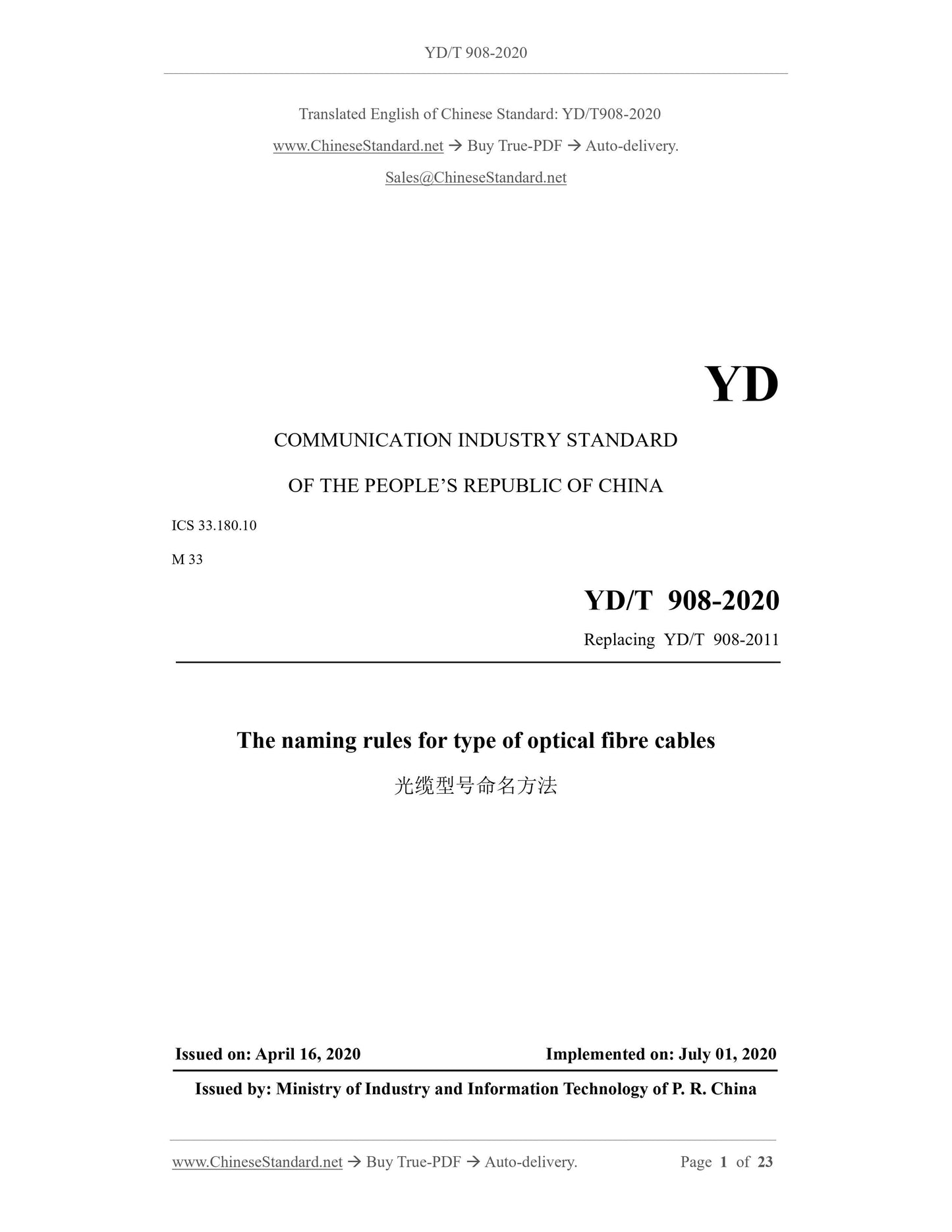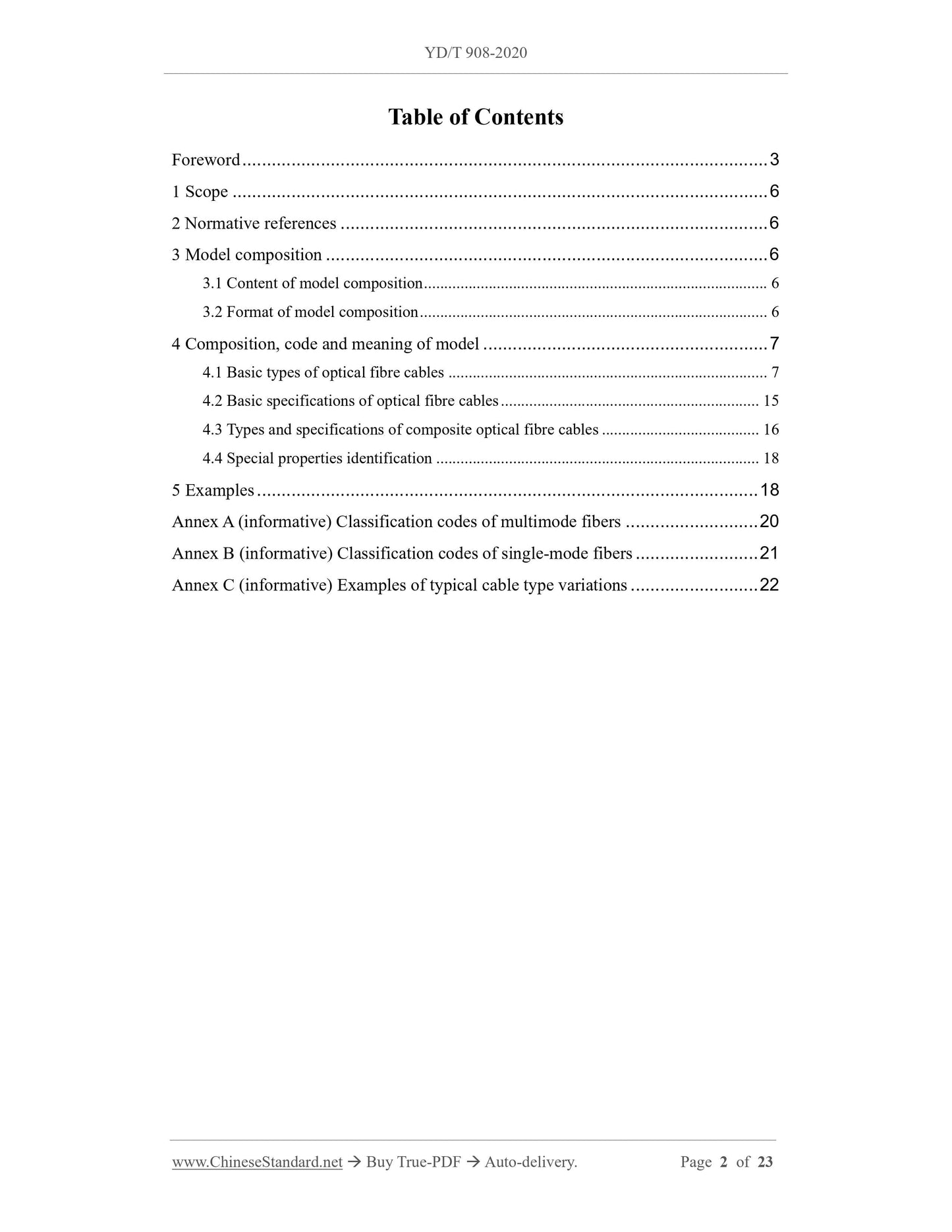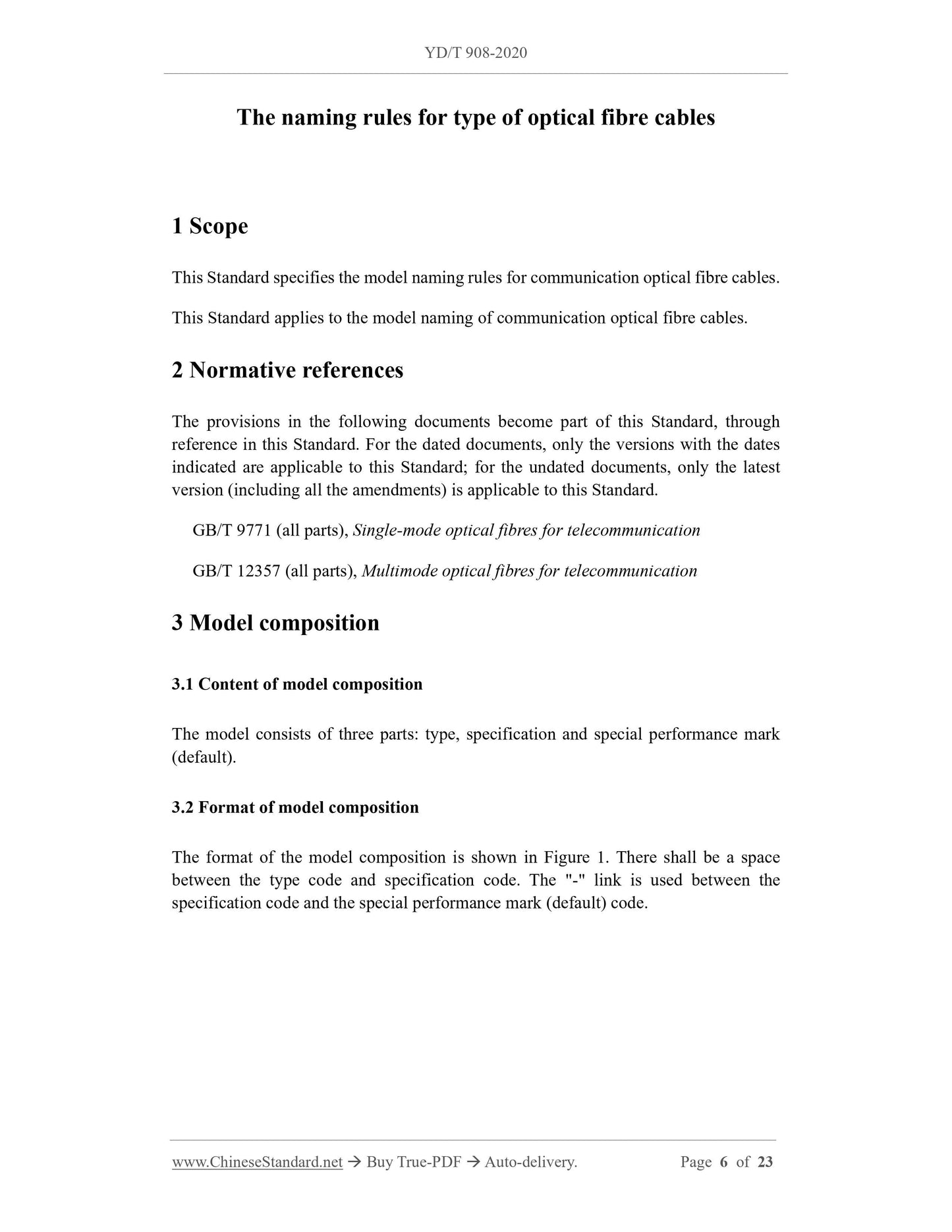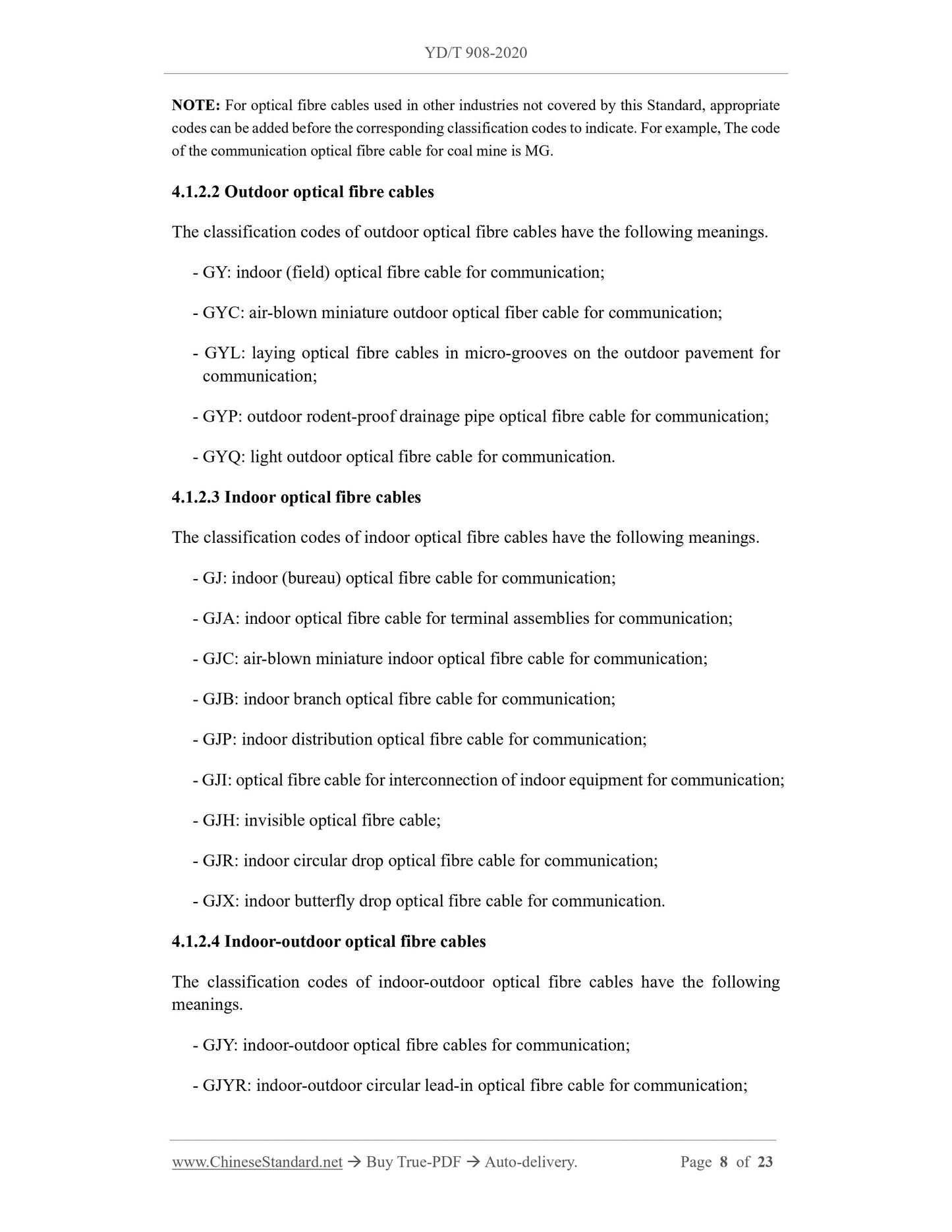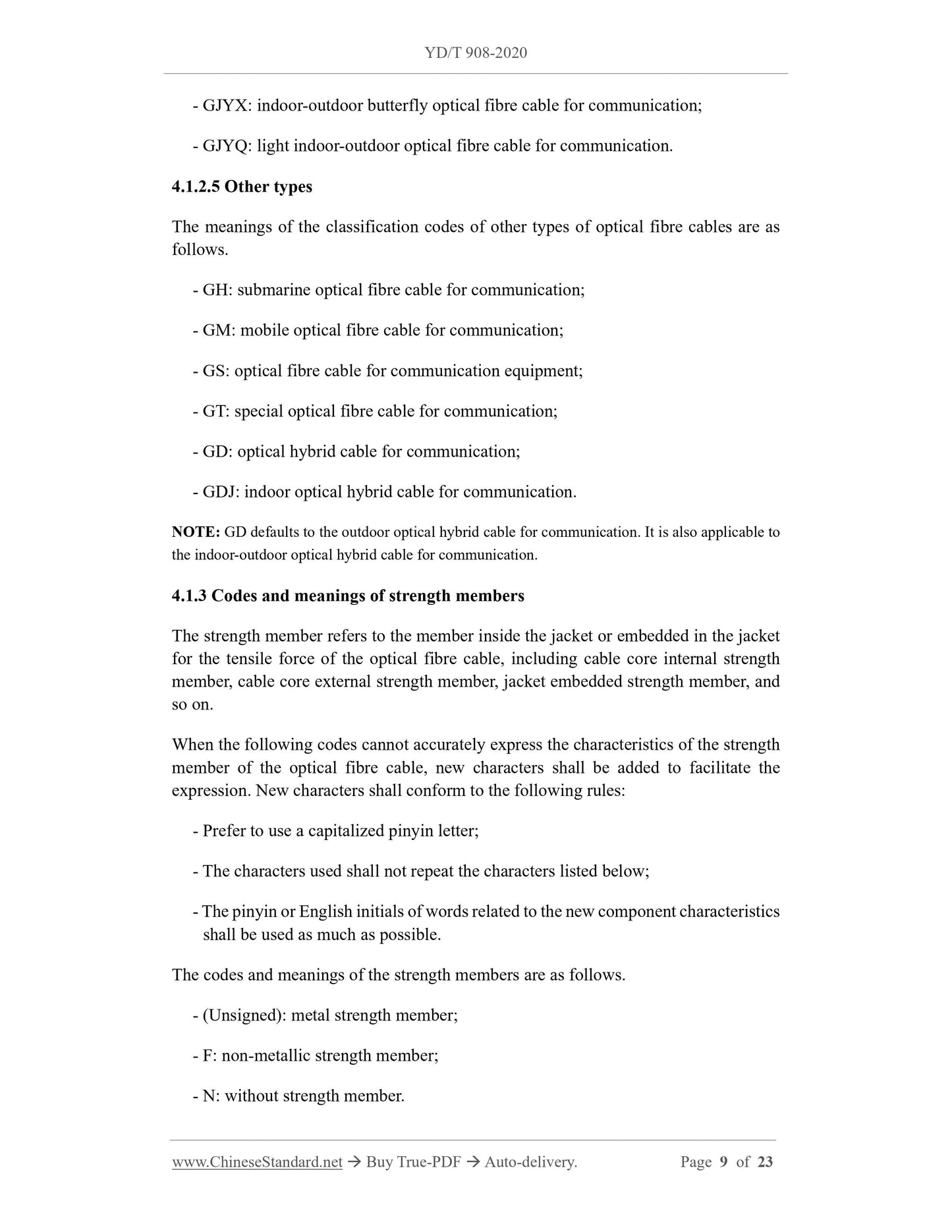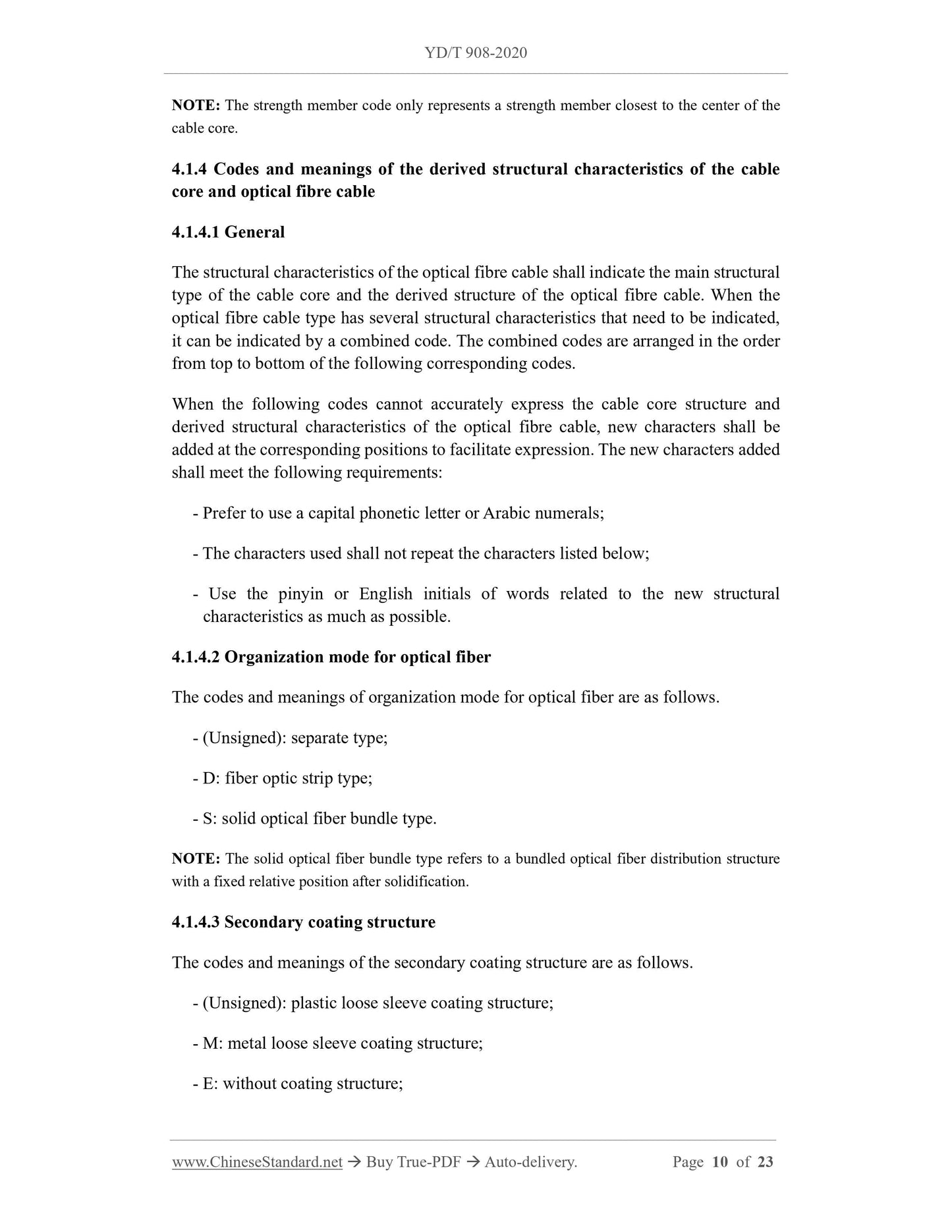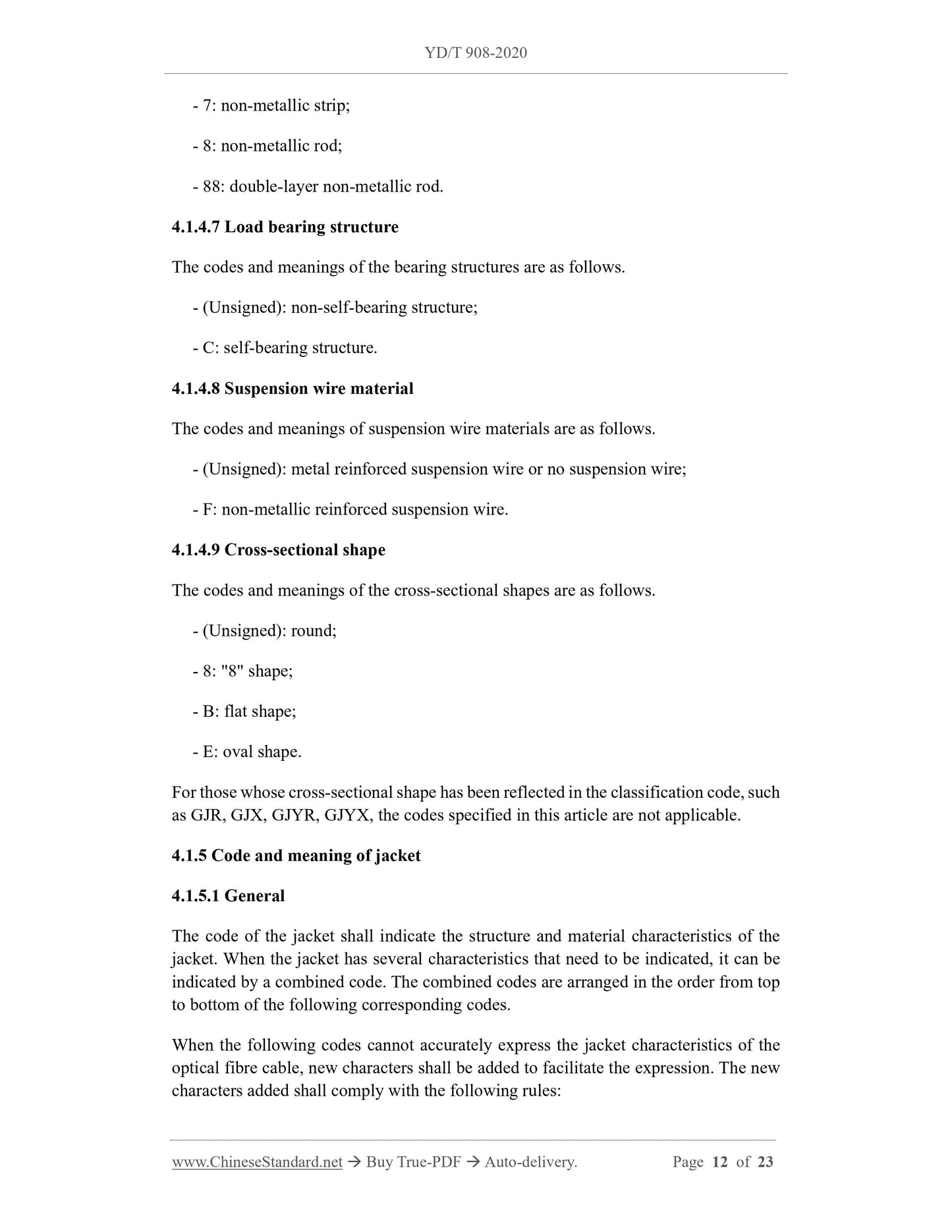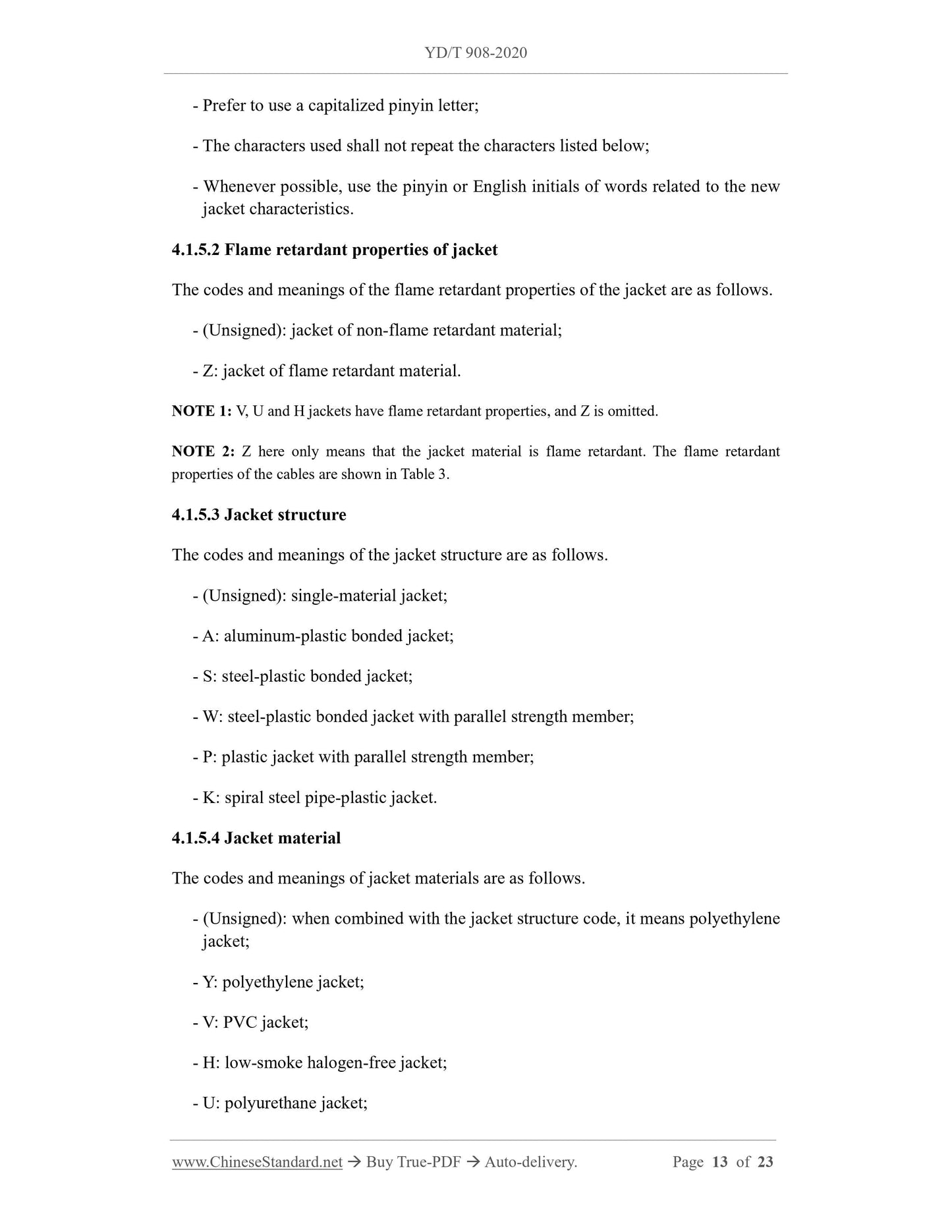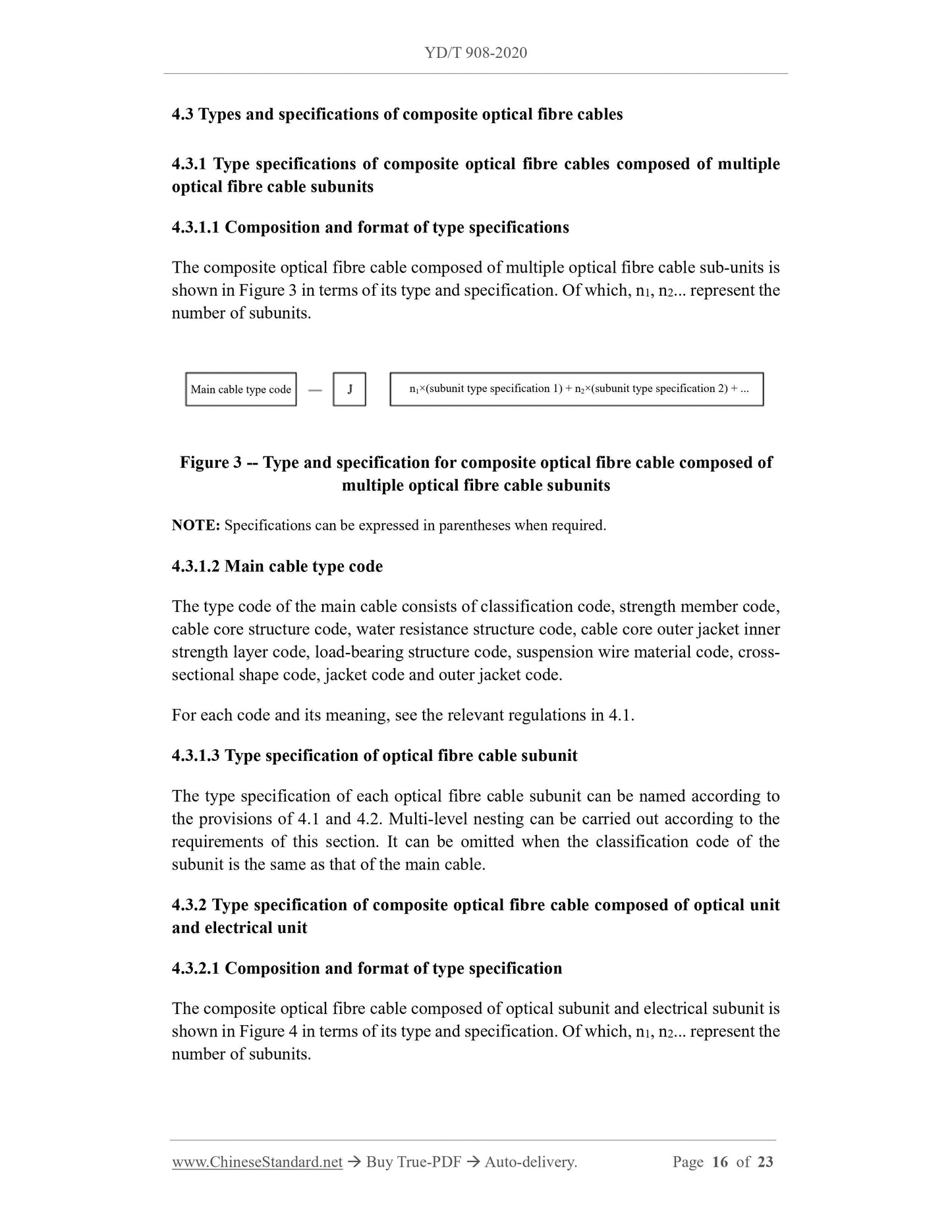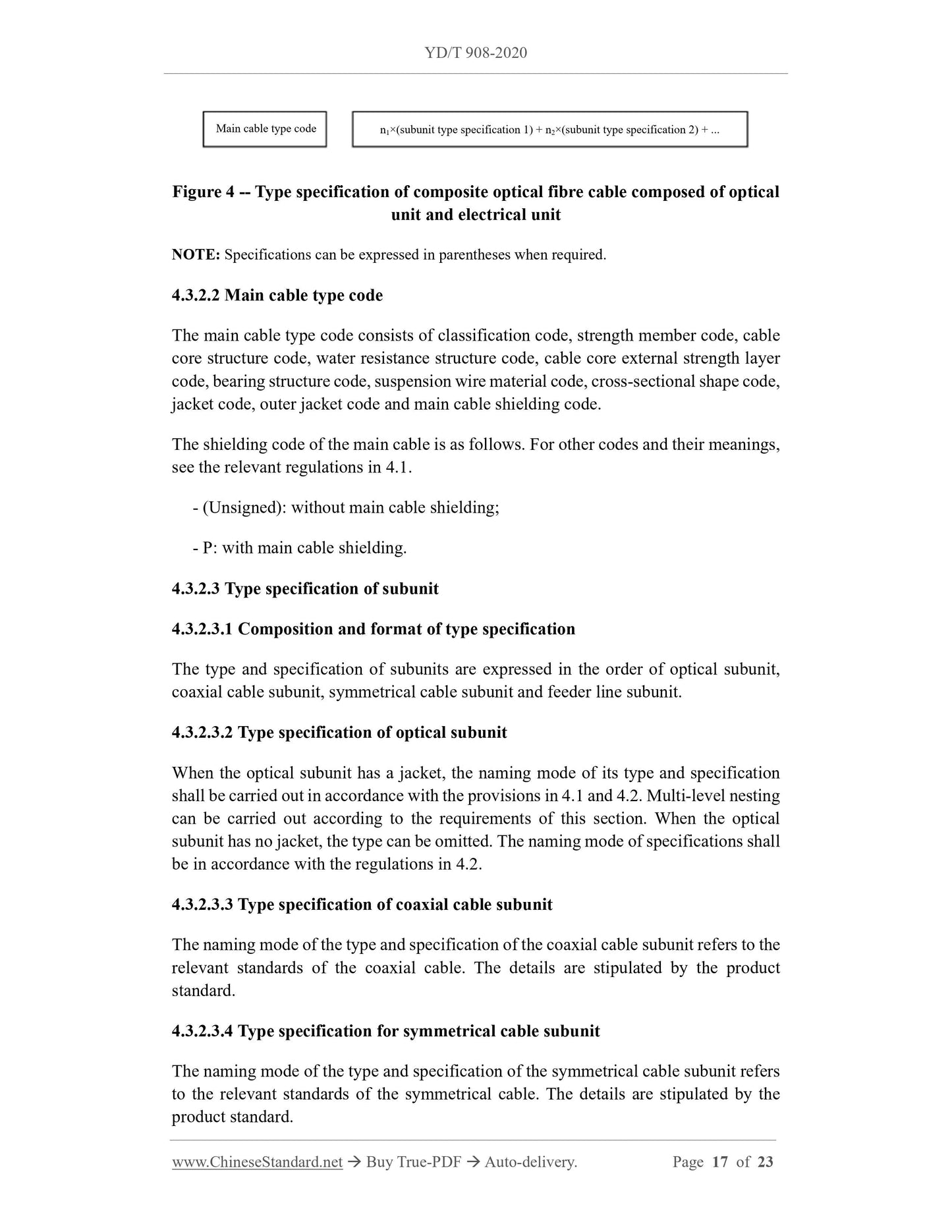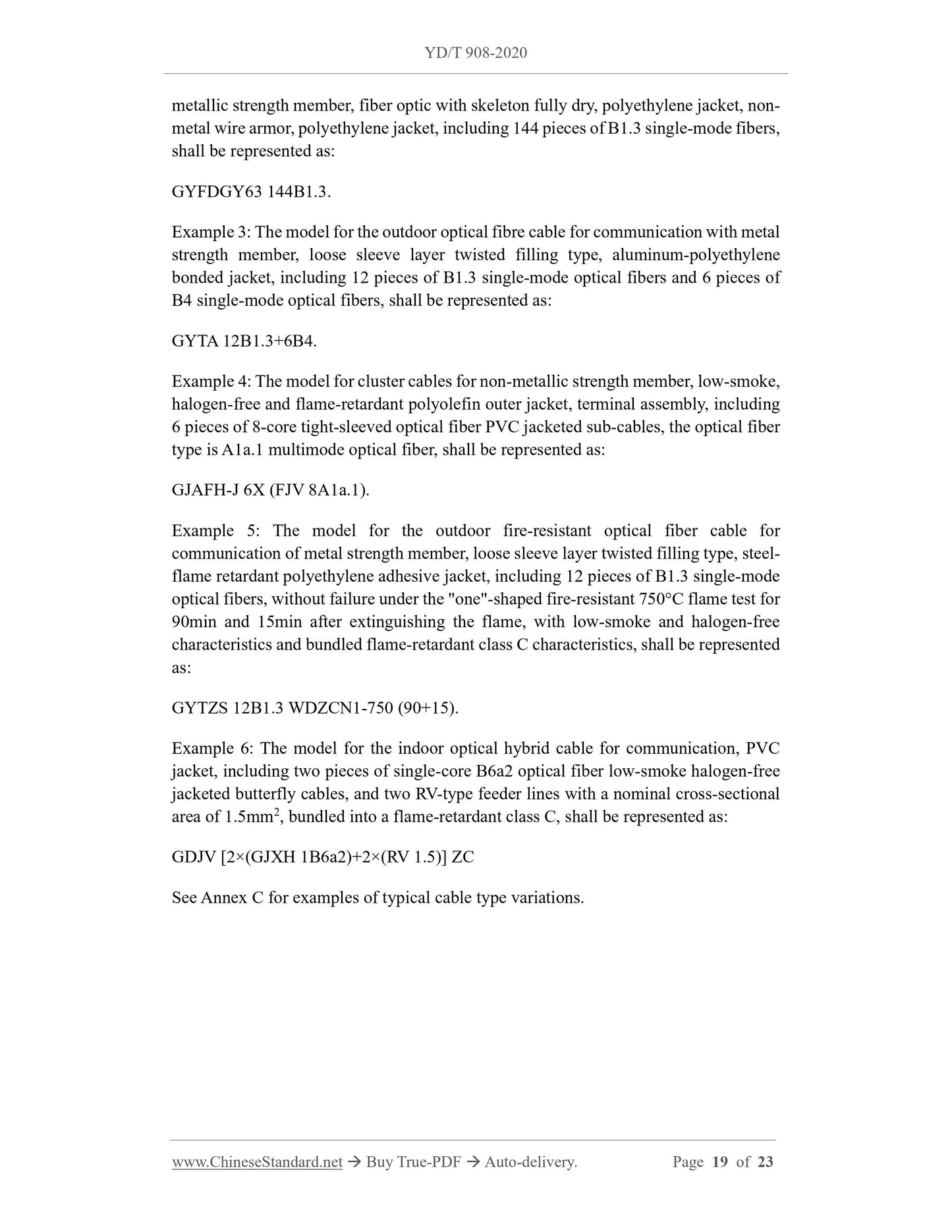1
/
of
11
PayPal, credit cards. Download editable-PDF and invoice in 1 second!
YD/T 908-2020 English PDF (YD/T908-2020)
YD/T 908-2020 English PDF (YD/T908-2020)
Regular price
$260.00 USD
Regular price
Sale price
$260.00 USD
Unit price
/
per
Shipping calculated at checkout.
Couldn't load pickup availability
Delivery: 3 seconds. Download true-PDF + Invoice.
Get QUOTATION in 1-minute: Click YD/T 908-2020
Historical versions: YD/T 908-2020
Preview True-PDF (Reload/Scroll if blank)
YD/T 908-2020: Naming rules for type of optical fibre cables
YD/T 908-2020
YD
COMMUNICATION INDUSTRY STANDARD
OF THE PEOPLE’S REPUBLIC OF CHINA
ICS 33.180.10
M 33
Replacing YD/T 908-2011
The naming rules for type of optical fibre cables
ISSUED ON: APRIL 16, 2020
IMPLEMENTED ON: JULY 01, 2020
Issued by: Ministry of Industry and Information Technology of P. R. China
Table of Contents
Foreword ... 3
1 Scope ... 6
2 Normative references ... 6
3 Model composition ... 6
3.1 Content of model composition ... 6
3.2 Format of model composition ... 6
4 Composition, code and meaning of model ... 7
4.1 Basic types of optical fibre cables ... 7
4.2 Basic specifications of optical fibre cables ... 15
4.3 Types and specifications of composite optical fibre cables ... 16
4.4 Special properties identification ... 18
5 Examples ... 18
Annex A (informative) Classification codes of multimode fibers ... 20
Annex B (informative) Classification codes of single-mode fibers ... 21
Annex C (informative) Examples of typical cable type variations ... 22
The naming rules for type of optical fibre cables
1 Scope
This Standard specifies the model naming rules for communication optical fibre cables.
This Standard applies to the model naming of communication optical fibre cables.
2 Normative references
The provisions in the following documents become part of this Standard, through
reference in this Standard. For the dated documents, only the versions with the dates
indicated are applicable to this Standard; for the undated documents, only the latest
version (including all the amendments) is applicable to this Standard.
GB/T 9771 (all parts), Single-mode optical fibres for telecommunication
GB/T 12357 (all parts), Multimode optical fibres for telecommunication
3 Model composition
3.1 Content of model composition
The model consists of three parts: type, specification and special performance mark
(default).
3.2 Format of model composition
The format of the model composition is shown in Figure 1. There shall be a space
between the type code and specification code. The "-" link is used between the
specification code and the special performance mark (default) code.
NOTE: For optical fibre cables used in other industries not covered by this Standard, appropriate
codes can be added before the corresponding classification codes to indicate. For example, The code
of the communication optical fibre cable for coal mine is MG.
4.1.2.2 Outdoor optical fibre cables
The classification codes of outdoor optical fibre cables have the following meanings.
- GY: indoor (field) optical fibre cable for communication;
- GYC: air-blown miniature outdoor optical fiber cable for communication;
- GYL: laying optical fibre cables in micro-grooves on the outdoor pavement for
communication;
- GYP: outdoor rodent-proof drainage pipe optical fibre cable for communication;
- GYQ: light outdoor optical fibre cable for communication.
4.1.2.3 Indoor optical fibre cables
The classification codes of indoor optical fibre cables have the following meanings.
- GJ: indoor (bureau) optical fibre cable for communication;
- GJA: indoor optical fibre cable for terminal assemblies for communication;
- GJC: air-blown miniature indoor optical fibre cable for communication;
- GJB: indoor branch optical fibre cable for communication;
- GJP: indoor distribution optical fibre cable for communication;
- GJI: optical fibre cable for interconnection of indoor equipment for communication;
- GJH: invisible optical fibre cable;
- GJR: indoor circular drop optical fibre cable for communication;
- GJX: indoor butterfly drop optical fibre cable for communication.
4.1.2.4 Indoor-outdoor optical fibre cables
The classification codes of indoor-outdoor optical fibre cables have the following
meanings.
- GJY: indoor-outdoor optical fibre cables for communication;
- GJYR: indoor-outdoor circular lead-in optical fibre cable for communication;
- GJYX: indoor-outdoor butterfly optical fibre cable for communication;
- GJYQ: light indoor-outdoor optical fibre cable for communication.
4.1.2.5 Other types
The meanings of the classification codes of other types of optical fibre cables are as
follows.
- GH: submarine optical fibre cable for communication;
- GM: mobile optical fibre cable for communication;
- GS: optical fibre cable for communication equipment;
- GT: special optical fibre cable for communication;
- GD: optical hybrid cable for communication;
- GDJ: indoor optical hybrid cable for communication.
NOTE: GD defaults to the outdoor optical hybrid cable for communication. It is also applicable to
the indoor-outdoor optical hybrid cable for communication.
4.1.3 Codes and meanings of strength members
The strength member refers to the member inside the jacket or embedded in the jacket
for the tensile force of the optical fibre cable, including cable core internal strength
member, cable core external strength member, jacket embedded strength member, and
so on.
When the following codes cannot accurately express the characteristics of the strength
member of the optical fibre cable, new characters shall be added to facilitate the
expression. New characters shall conform to the following rules:
- Prefer to use a capitalized pinyin letter;
- The characters used shall not repeat the characters listed below;
- The pinyin or English initials of words related to the new component characteristics
shall be used as much as possible.
The codes and meanings of the strength members are as follows.
- (Unsigned): metal strength member;
- F: non-metallic strength member;
- N: without strength member.
NOTE: The strength member code only represents a strength member closest to the center of the
cable core.
4.1.4 Codes and meanings of the derived structural characteristics of the cable
core and optical fibre cable
4.1.4.1 General
The structural characteristics of the optical fibre cable shall indicate the main structural
type of the cable core and the derived structure of the optical fibre cable. When the
optical fibre cable type has several structural characteristics that need to be indicated,
it can be indicated by a combined code. The combined codes are arranged in the order
from top to bottom of the following corresponding codes.
When the following codes cannot accurately express the cable core structure and
derived structural characteristics of the optical fibre cable, new characters shall be
added at the corresponding positions to facilitate expression. The new characters added
shall meet the following requirements:
- Prefer to use a capital phonetic letter or Arabic numerals;
- The characters used shall not repeat the characters listed below;
- Use the pinyin or English initials of words related to the new structural
characteristics as much as possible.
4.1.4.2 Organization mode for optical fiber
The codes and meanings of organization mode for optical fiber are as follows.
- (Unsigned): separate type;
- D: fiber optic strip type;
- S: solid optical fiber bundle type.
NOTE: The solid optical fiber bundle type refers to a bundled optical fiber distribution structure
with a fixed relative position after solidification.
4.1.4.3 Secondary coating structure
The codes and meanings of the secondary coating structure are as follows.
- (Unsigned): plastic loose sleeve coating structure;
- M: metal loose sleeve coating structure;
- E: without coating structure;
- 7: non-metallic strip;
Get QUOTATION in 1-minute: Click YD/T 908-2020
Historical versions: YD/T 908-2020
Preview True-PDF (Reload/Scroll if blank)
YD/T 908-2020: Naming rules for type of optical fibre cables
YD/T 908-2020
YD
COMMUNICATION INDUSTRY STANDARD
OF THE PEOPLE’S REPUBLIC OF CHINA
ICS 33.180.10
M 33
Replacing YD/T 908-2011
The naming rules for type of optical fibre cables
ISSUED ON: APRIL 16, 2020
IMPLEMENTED ON: JULY 01, 2020
Issued by: Ministry of Industry and Information Technology of P. R. China
Table of Contents
Foreword ... 3
1 Scope ... 6
2 Normative references ... 6
3 Model composition ... 6
3.1 Content of model composition ... 6
3.2 Format of model composition ... 6
4 Composition, code and meaning of model ... 7
4.1 Basic types of optical fibre cables ... 7
4.2 Basic specifications of optical fibre cables ... 15
4.3 Types and specifications of composite optical fibre cables ... 16
4.4 Special properties identification ... 18
5 Examples ... 18
Annex A (informative) Classification codes of multimode fibers ... 20
Annex B (informative) Classification codes of single-mode fibers ... 21
Annex C (informative) Examples of typical cable type variations ... 22
The naming rules for type of optical fibre cables
1 Scope
This Standard specifies the model naming rules for communication optical fibre cables.
This Standard applies to the model naming of communication optical fibre cables.
2 Normative references
The provisions in the following documents become part of this Standard, through
reference in this Standard. For the dated documents, only the versions with the dates
indicated are applicable to this Standard; for the undated documents, only the latest
version (including all the amendments) is applicable to this Standard.
GB/T 9771 (all parts), Single-mode optical fibres for telecommunication
GB/T 12357 (all parts), Multimode optical fibres for telecommunication
3 Model composition
3.1 Content of model composition
The model consists of three parts: type, specification and special performance mark
(default).
3.2 Format of model composition
The format of the model composition is shown in Figure 1. There shall be a space
between the type code and specification code. The "-" link is used between the
specification code and the special performance mark (default) code.
NOTE: For optical fibre cables used in other industries not covered by this Standard, appropriate
codes can be added before the corresponding classification codes to indicate. For example, The code
of the communication optical fibre cable for coal mine is MG.
4.1.2.2 Outdoor optical fibre cables
The classification codes of outdoor optical fibre cables have the following meanings.
- GY: indoor (field) optical fibre cable for communication;
- GYC: air-blown miniature outdoor optical fiber cable for communication;
- GYL: laying optical fibre cables in micro-grooves on the outdoor pavement for
communication;
- GYP: outdoor rodent-proof drainage pipe optical fibre cable for communication;
- GYQ: light outdoor optical fibre cable for communication.
4.1.2.3 Indoor optical fibre cables
The classification codes of indoor optical fibre cables have the following meanings.
- GJ: indoor (bureau) optical fibre cable for communication;
- GJA: indoor optical fibre cable for terminal assemblies for communication;
- GJC: air-blown miniature indoor optical fibre cable for communication;
- GJB: indoor branch optical fibre cable for communication;
- GJP: indoor distribution optical fibre cable for communication;
- GJI: optical fibre cable for interconnection of indoor equipment for communication;
- GJH: invisible optical fibre cable;
- GJR: indoor circular drop optical fibre cable for communication;
- GJX: indoor butterfly drop optical fibre cable for communication.
4.1.2.4 Indoor-outdoor optical fibre cables
The classification codes of indoor-outdoor optical fibre cables have the following
meanings.
- GJY: indoor-outdoor optical fibre cables for communication;
- GJYR: indoor-outdoor circular lead-in optical fibre cable for communication;
- GJYX: indoor-outdoor butterfly optical fibre cable for communication;
- GJYQ: light indoor-outdoor optical fibre cable for communication.
4.1.2.5 Other types
The meanings of the classification codes of other types of optical fibre cables are as
follows.
- GH: submarine optical fibre cable for communication;
- GM: mobile optical fibre cable for communication;
- GS: optical fibre cable for communication equipment;
- GT: special optical fibre cable for communication;
- GD: optical hybrid cable for communication;
- GDJ: indoor optical hybrid cable for communication.
NOTE: GD defaults to the outdoor optical hybrid cable for communication. It is also applicable to
the indoor-outdoor optical hybrid cable for communication.
4.1.3 Codes and meanings of strength members
The strength member refers to the member inside the jacket or embedded in the jacket
for the tensile force of the optical fibre cable, including cable core internal strength
member, cable core external strength member, jacket embedded strength member, and
so on.
When the following codes cannot accurately express the characteristics of the strength
member of the optical fibre cable, new characters shall be added to facilitate the
expression. New characters shall conform to the following rules:
- Prefer to use a capitalized pinyin letter;
- The characters used shall not repeat the characters listed below;
- The pinyin or English initials of words related to the new component characteristics
shall be used as much as possible.
The codes and meanings of the strength members are as follows.
- (Unsigned): metal strength member;
- F: non-metallic strength member;
- N: without strength member.
NOTE: The strength member code only represents a strength member closest to the center of the
cable core.
4.1.4 Codes and meanings of the derived structural characteristics of the cable
core and optical fibre cable
4.1.4.1 General
The structural characteristics of the optical fibre cable shall indicate the main structural
type of the cable core and the derived structure of the optical fibre cable. When the
optical fibre cable type has several structural characteristics that need to be indicated,
it can be indicated by a combined code. The combined codes are arranged in the order
from top to bottom of the following corresponding codes.
When the following codes cannot accurately express the cable core structure and
derived structural characteristics of the optical fibre cable, new characters shall be
added at the corresponding positions to facilitate expression. The new characters added
shall meet the following requirements:
- Prefer to use a capital phonetic letter or Arabic numerals;
- The characters used shall not repeat the characters listed below;
- Use the pinyin or English initials of words related to the new structural
characteristics as much as possible.
4.1.4.2 Organization mode for optical fiber
The codes and meanings of organization mode for optical fiber are as follows.
- (Unsigned): separate type;
- D: fiber optic strip type;
- S: solid optical fiber bundle type.
NOTE: The solid optical fiber bundle type refers to a bundled optical fiber distribution structure
with a fixed relative position after solidification.
4.1.4.3 Secondary coating structure
The codes and meanings of the secondary coating structure are as follows.
- (Unsigned): plastic loose sleeve coating structure;
- M: metal loose sleeve coating structure;
- E: without coating structure;
- 7: non-metallic strip;
Share
